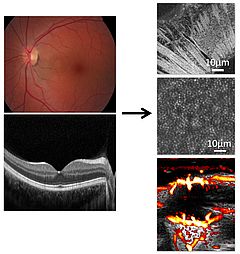You are here: vision-research.eu » Vision Research » Vision in the European Focus » 2014 » A sight for sore eyes: New techniques for improved vision
A sight for sore eyes: New techniques for improved vision

Over 50 million patients in the EU and the US suffer from low vision, with costs of visual impairment in the EU alone estimated at over EUR 500 billion. The HELMHOLTZ project, which brings together two leading research institutes, aims at developing prototypes for new non-invasive imaging technologies for ophthalmology. These prototypes should help to treat age-related diseases such as genetic diseases, age-related macular degeneration, glaucoma or diabetic retinopathy.
By using state-of-the art techniques, in particular the ultrafast doppler imaging, the team will provide 4D functional maps of the visual system, especially for the central part of the human retina called the “macula”. They will also explore the cellular structure of the eyes’ photoreceptors and the alterations in pressure and blood flow in the retina, the optic nerve and the choroid (a micro vasculature irrigating the retina).
What makes this project innovative is that it merges the expertise of clinician-scientists on the one hand with physicists on the other. Initial trials are foreseen to test these new technologies against current methods. As the retina is “the most approachable part of the brain”, the group imagines that its results could expand to other research areas, such as neuroscience and the treatment of neurodegenerative diseases.
Project title:
Holistic Evaluation of Light and Multiwave applications to High resolution imaging in Ophthalmic Translational research: revisiting the HelmholtZian synergies (HELMHOLTZ)
Principal investigators:
- José-Alain Sahel, Fondation Voir et Entendre, Institut de la Vision (UPMC, Inserm, CNRS), France
- Mathias Fink, Fondation Pierre-Gilles de Gennes, Institut Langevin (ESPCI, CNRS), France
ERC funding:
- EUR 11.9 million
European Commissioner for Research, Innovation and Science Máire Geoghegan-Quinn commented: "You have to take risks to get exceptional results. ERC Synergy Grants invest in remarkable research, bringing together top-notch scientists. These projects will push the frontiers of our knowledge. That’s exactly the type of science that we need if we are to make Europe more innovative and globally competitive."
On this occasion, ERC President Helga Nowotny said: "The eagerly awaited outcome of the second ERC Synergy Grant has yielded some truly exciting science among the 13 projects selected. Applicants have understood well that 'Synergy' entails the unique combination of individual skills and knowledge, often crossing disciplinary boundaries in exceptionally innovative ways. The results prove that the strength of the Synergy Grant lies in enabling up to four top scientists to jointly tackle a challenging problem where none of them could succeed alone. The Scientific Council will soon carefully assess its experience with this innovative pilot scheme.”
More information on the ERC website and in the offical ERC press release [pdf]



